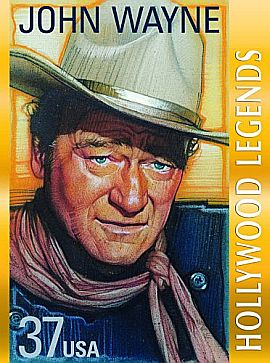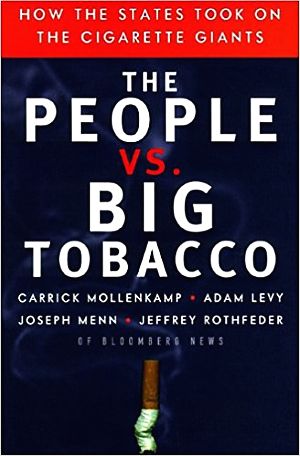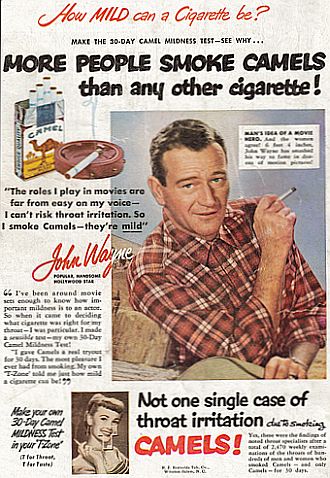
John Wayne, a highly-popular Hollywood film star, appears in a 1950 magazine ad for Camel cigarettes.
The Camel cigarette brand, introduced by the R. J. Reynolds Tobacco Co. in 1913, had become the top selling cigarette in the U.S. by the 1950s, thanks in part to the company’s heavy advertising.
John Wayne had been a chain-smoker since young adulthood, so it was not out of character for him, or surprising for those times, to see him in a cigarette ad. Numerous other celebrities — and athletes as well — also did such ads in those days.
Edward R. Murrow, for example, a popular TV news broadcaster, smoked up to four packs of Camels per day. Cigarettes with Murrow almost seemed to serve as stage prop, becoming part of his TV image, as he was often photographed with a cigarette or seen smoking during his TV shows, such as Person to Person.
John Wayne, by the time he appeared in the 1950 print ad at right, was at the peak of his movie career. Wayne had already achieved stardom in motion pictures by the early 1940s, and by the end of the decade was one of Hollywood’s top ten box office attractions.
During the latter half of the 1940s Wayne had starred in notable westerns and other films including: Fort Apache (1948), Red River (1948), 3 Godfathers (1948), She Wore a Yellow Ribbon (1949), and Rio Grande (1950).
Wayne by then had also begun producing some of his own films. He also did a number of war movies, including: The Flying Tigers (1942), Back To Battan (1944), The Fighting Seabees(1944), Sands of Iow Jima (1949), Flying Leathernecks (1951), Operation Pacific (1951). And there would also come other notable films in the early 1950s, such as and The Quiet Man (1952) and Hondo (1953). Wayne was the biggest box-office attraction in 1950, 1951, and the third most popular star of 1952. On television by this time as well, his earlier movies, especially westerns, were regular fare — though he was not a star on a specific TV show; he didn’t need one.
|
The Tobacco Celebrities This is one in a series of occasional articles that will focus on the history of popular celebrities from film, tele- vision, sports and other fields who have lent their names or voice, offered endorsing statements, or made person- al appearances in various forms of tobacco advertising and promotion. Famous actors, sports stars and other notable personalities have been endors- ing tobacco products since the late 1800s. One recent report published in the journal Tobacco Control, for example, notes that nearly 200 Hollywood stars from the 1930s and 1940s were contracted to tobacco companies for advertising. And while the stigma associated with smoking and using other tobacco products has increased in recent years as medical research evidence linking disease to tobacco has become more widely understood, the promotion of tobacco products, while not as blatant and pervasive as it once was, continues to this day in a number of countries. Not all celebrities, of course, have been involved in such endorsements, and some have worked for, or lent their names to, programs and organizations that help to prevent cigarette smoking or other tobacco-related public health problems. |
In the Camel cigarette ad above, pushing the “Camels-are-mild” line, Wayne is quoted as saying: “The roles I play in movies are far from easy on my voice — I can’t risk throat irritation. So I smoke Camels — they are mild.”
Wayne continues his endorsement below the highlighted passage with the following: “I’ve been around movie sets enough to know how important mildness is to an actor. So when it came to deciding what cigarette was right from my throat — I was particular I made a sensible test — my own 30-Day Camels Mildness Test. I gave Camels a real tryout for 30 days. The most pleasure I ever had from smoking. My own T-Zone told me just how mild a cigarette can be.”
R. J. Reynolds in the 1940s had already started touting Camels for their smoothness and taste. The company also invented the “T-Zone” description for use in advertising, with some ads showing a white-lined area of the mouth and throat as the “T-Zone” (as in the woman’s photograph, lower left-hand corner in this ad). And parenthetically at one point the ad also explains, “T for taste, T for throat.” Wording of this sort would also appear in other Camel ad copy of the early 1950s, as well as in the quotes of celebrity endorsers.
The Stanford University School of Medicine has noted that “throat cancer was well-recognized by the middle of the nineteenth century,” known then as “smoker’s cancer.” And the tobacco industry, in advertising dating from the 1930s through the 1950s, used a strategy of “throat reassurance” to allay such fears, casting its celebrity voices in ways that stressed how their particular cigarette brands were mild on the throat.
As the Wayne ad above continues, readers are encouraged to make their own “30 Day Mildness test.” Then the ad signs off with the bold headline in the lower right: “Not One Single Case of Throat Irritation …Due to Smoking Camels!” Justifying this claim comes some additional copy in smaller print as follows: “Yes, those were the findings of noted throat specialists after a total of 2,470 weekly examinations of the throats of hundreds of men and women who smoked Camels — and only Camels — for 30 Days.”
The ad also includes some description of Wayne the movie star meant to appeal to men and women, as a small box to the right of his photo explains: “Man’s Idea of a Movie Hero. And the women agree. 6 feet 4 inches, John Wayne has smashed his way to fame in dozens of motion pictures!”

An R. J. Reynolds magazine ad for Camel cigarettes features Hollywood star John Wayne, appearing to offer a personal note in his endorsement of Camels. Life magazine, July 1954.
By mid-1954, Wayne was featured in more full-page R. J. Reynolds ads for Camels. One, shown at right, has Wayne leaning back in a cane chair in a country cabin setting with cigarette in hand. The headline reads: “John Wayne…a Camel fan goin’ on 24 years!” Just below the headline is a hand-written note, with envelope behind it, as Wayne explains his many years of Camel loyalty:
“…in all that time, a man learns how to enjoy smoking – for mildness, for flavor, for pure pleasure. It’s kind of gratifying to see that my cigarette is America’s choice, too. John Wayne.”
The ad’s copy then continues: “Talk to Camel smokers like John Wayne, popular Hollywood star, and you’ll quickly see why Camels keep increasing their lead over the next brand! Clearly, nothing matches Camels’ blend of costly tobaccos for genuine mildness and specially-rich flavor! If you smoke for the pure pleasure of smoking, try Camels for 30 days. See what you’ve been missing!”
Then in somewhat smaller italic print immediately below, comes a further appeal: “Make your own 30 day Camel Mildness Test…see why more people find more pleasure in Camels year after year!”
Continuing near the bottom of the ad comes some information about Camels in the market: “Camels First in Sales! Lead second brand by record 50.8 %.” The ad’s closing pitch comes as follows: “For Mildness… for Flavor. Camels agree with more people than any other cigarette!” This ad appeared on the back cover of Life magazine’s July 12, 1954 issue. It also appeared in Popular Mechanics and possibly other magazines of that time as well.

John Wayne in 1961, from the film “The Challenge of Ideas.”
This commercial was filmed in conjunction with Wayne’s then forthcoming movie, Big Jim McLain, as the tobacco industry and Hollywood commonly engaged in cross-promotion deals in some of their advertising. By the mid-1950s, Wayne reportedly was a five-to-six pack-a-day smoker of unfiltered Camels.
Wayne, of course, continued his stellar Hollywood career through the mid-1950s and early 1960s, making films such as: The High and the Mighty (1954), The Sea Chase (1955), The Searchers (1956), The Barbarian and the Geisha(1958), Rio Bravo(1959), The Alamo (1960), The Comancheros (1961), The Challenge of Ideas (1961), and The Man Who Shot Liberty Valance (1962).

John Wayne print ad.
Lung Cancer
In 1964, at age 57, John Wayne was diagnosed with lung cancer and underwent successful surgery. By one account, a lung tumor “the size of a baseball” was removed, along with his entire left lung and four ribs. “I was lucky,” he would later say of the discovery and outcome. “I’d never been sick before in my life but I always took an annual checkup at the Scripps Clinic at La Jolla [Calif.]. The X-rays showed a spot on my lung….” The surgery followed at Good Samaritan Hospital in Los Angeles.
Initially, after his surgery in 1964, Wayne withheld news of his cancer since his advisers “all thought it would destroy my image” and impact his ability to get work in Hollywood. Yet, according to the suggestion of some of Wayne’s doctors, there would also be a positive message in “John Wayne beating cancer.” So Wayne reversed the decision to keep his cancer surgery private, explaining: “I thought to myself: ‘I was saved by early detection. Movie image or not, I think I should tell my story so that other people can be saved by getting annual checkups.’” And later he would make a series of short public service TV ads for the American Cancer Society urging medical check-ups.
Similar print ads with his image appeared as well, also urging medical checkups. The ad at right, for example, appeared in some magazines, bearing the headline: “My Biggest Fight Wasn’t in Pictures,” with additional text as follows:
It happened in real life. I was just finishing my 99th ridin`, jumpin`, fightin` picture. Never felt better in my life.
But my family nagged me into getting a medical checkup. And it turned out I had lung cancer. If I’d waited a few more weeks, I’d be kicking up daisies now.
So, friend, I know what I’, talking about when I tell you get a checkup. Talk someone you like into getting a checkup. Nag someone you love into getting a checkup.
And when the lady from the American Cancer Society rings your doorbell, dig deep in your pocket. They’re working to rid this world of cancer once and for all.
American Cancer Society. “We want to wipe out cancer in your lifetime”.
Five years following his surgery, Wayne was declared cancer-free. However, despite the fact that Wayne’s diminished lung capacity left him incapable of prolonged exertion and frequently in need of supplemental oxygen, he returned to using some tobacco products. Within a few years of his operation Wayne chewed tobacco and also began smoking cigars.
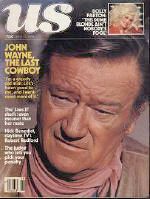
Wayne was interviewed about his health & smoking in 1978.
In January 1979 Wayne returned to the hospital for lower abdomen surgery, when a low-grade cancerous tumor was found and part of his lower intestine was removed. In June 1979, Wayne died at the at UCLA Medical Center. The cause of death was reported as complications from cancer. Wayne was 72 years old.
In 1956, Wayne had been part of the 220 or so cast and crew who made the film, The Conqueror, near St. George, Utah, downwind from where the U.S. Government had tested nuclear weapons in southeastern Nevada. An astounding ninety-one people from that group, or 41 percent — including stars such as Susan Hayward and Agnes Moorehead in addition to Wayne — had come down with cancer. Many who were at that filming location contend that radioactive fallout from the government’s tests contaminated the location and poisoned the film crew.
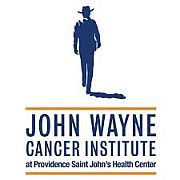
Logo, John Wayne Cancer Institute.
In the 1980s, Wayne’s family created the John Wayne Cancer Foundation and later, the John Wayne Cancer Institute, to help fight cancer with awareness and education programs and cancer research.
John Wayne remains an iconic figure in American culture, having appeared in more than 250 films during his career, more than half of which he had the lead role. He was formally recognized by the United States Congress on May 26, 1979, when he was awarded the Congressional Gold Medal, presented to his family at a formal ceremony in March 1980 at the U.S. Capitol. In early June 1980, Wayne also received posthumously the Presidential Medal of Freedom from President Jimmy Carter.
Some years later, in March 2019, an earlier Playboy magazine interview with Wayne from May 1971 surfaced in the social media, provoking criticisms of Wayne for his then-stated opinions about African Americans, Native Americans (e.g., “I believe in white supremacy”), and other issues, with some charging his comments were racist and homophobic, in the latter case for his remarks on the film, Midnight Cowboy.Wayne’s son, Ethan, defended his father, suggesting that judgements based on the 1971 Playboy interview were being made out of context.
Wayne, in any case, had a long history of conservative politics, supporting and campaigning for, among others, presidents Richard Nixon and Ronald Reagan.
In his personal life, John Wayne had been married three times and divorced twice. His three wives, one of Spanish American descent and two of Hispanic descent, were Josephine Alicia Saenz, Esperanza Baur, and Pilar Pallete.
Readers of “Wayne for Camels” may also find the following stories of interest: “Al Jolson & Luckies, 1928-1940s” (Jolson as pitchman; Hollywood studios & tobacco companies);“Babe Ruth & Tobacco, 1920s-1940s” (baseball legend & tobacco products); “Gifford For Luckies, 1961-1962” (Frank Gifford, football star, promoting Lucky brand cigarettes); “Vines for Camels, 1934-1935” (Ellsworth Vines, tennis star in Camels ad); and, “21 of 23 Giants…Smoke Camels” (entire World Series team of 1933 used in ad to pitch cigarettes).
Thanks for visiting – and if you like what you find here, please make a donation to help support the research and writing at this website. Thank you. – Jack Doyle
|
Please Support Thank You |
_____________________________
Date Posted: 29 January 2010
Last Update: 19 March 2019
Comments to: jdoyle@pophistorydig.com
Article Citation:
Jack Doyle, “Wayne For Camels, 1950s,”
PopHistoryDig.com, January 29, 2010.
______________________________
Sources, Links & Additional Information
Moirafinnie, “Smoke Gets In Your Eyes,” Movie Morlocks.com, May 13, 2009.
“Camel Cigarettes: Advertising Methodologies Through The 20th Century,” IndyMotor Speedway.com.
Listing of R.J. Reynolds Tobacco Co. Advertise- ments, 1933-1969, TJS-Labs.com.
K.L Lum, J.R Polansky, R.K. Jackler, and S.A. Glantz, “Signed, Sealed and Delivered: ‘Big Tobacco’ in Hollywood, 1927-1951,” Tobacco Control Journal, September 25, 2008.
Ewen Callaway, “Hollywood Cut Secret Deals to Promote Smoking,” NewScientist.com, September 25, 2008.
James Bacon, “‘I’ve Licked It’; John Wayne Says He Had Cancer; Movie Star Reveals Operation Removed Malignancy in Lung,” Los Angeles Times, December 30, 1964.
Associated Press, “John Wayne Tells of Cancer Surgery,” New York Times, Tuesday, December 31, 1964, p. 13.
Grace Lichtenstein, “Hey, Mister! Wayne Marks First 50 Years,” New York Times, Tuesday, January 27, 1976, p. 48.
James Bacon, “John Wayne: The Last Cowboy,” US Magazine, June 27,1978, @ JWayne.com.
Around the Nation, “More Cancer Is Found In Surgery on John Wayne..,” New York Times, Saturday, May 5, 1979, p. 8.
AP, “John Wayne Dead of Cancer on Coast at 72,” New York Times, Tuesday, June 12, 1979, p. A-1.
Richard F. Shepard, “‘Duke,’ An American Hero,” New York Times, June 12, 1979
Editorial, “The Part John Wayne Played,” New York Times, Wednesday, June 13, 1979, p. A-24.
“John Wayne,” Wikipedia.org.
Garry Wills, John Wayne’s America: The Politics of Celebrity, Simon & Schuster, 1997.
Randy Roberts and James S. Olson, John Wayne: American, The Free Press, 1995.
Joseph McBride, Searching for John Ford, St. Martin’s Press, 2001.
Scott Eyman, Print the Legend: The Life and Times of John Ford, Simon & Schuster, 2000.
John Wayne Cancer Foundation and John Wayne Cancer Institute.
Alan Greenblatt, “An Actor, A University And A Famous Name Lead To A Lawsuit,” NPR.org, July 9, 2014.
________________________
